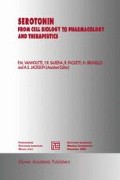Abstract
In this work, we evaluated the role of 5-HT and 5-HT3receptors on the emetic response to antineoplastic drugs, in human patients with cancer. 1) 5HT3antagonists prevented vomiting induced by cisplatinum or cyclophosphamidebased chemotherapies. Emesis ensuing after high doses of ondansetron would be mediated by a non-5-HT3receptor mechanism (delayed emesis?). 2) Increases in plasma and on the urinary excretion of 5-hydroxyindoleacetic acid (5-HIAA) were produced by highly emetogenic treatments (high-dose cisplatinum or dacarbazinebased chemotherapies). For both drugs, the time courses for emesis were superimposed with those for the increases in 5-HIAA. With high-dose cisplatinum, the increases in 5-HIAA lasted 12 to 14 hours and no increases in 5-HIAA were observed during the period of delayed emesis. Platelet or plasma 5-HT were not modified by cisplatinum or cyclophosphamide. A direct relationship was observed between emetogenecity and serotonin-releasing properties of the drugs. The antiemetics, ondansetron, metoclopramide, and dexamethasone failed to modify the increases in 5-HIAA induced by high-dose cisplatinum. The emetic response and the increases in 5-HT metabolism induced by cisplatinum were not affected by the somatostatin analog (octreotide). These results suggest that 5-HT and 5-HT3receptors mediate the early, intense emetic response to chemotherapy. 5-HT appears to be released from the gut, since urinary 5-HIAA is a marker of gastrointestinal content and turnover of 5-HT and since platelet 5-HT does not contribute to the increases in 5-HIAA. Damage of the gut mucosa may be responsible for the release of serotonin induced by high-dose cisplatinum.
Access this chapter
Tax calculation will be finalised at checkout
Purchases are for personal use only
Preview
Unable to display preview. Download preview PDF.
References
Andrews, R.L.R. (1992) ‘Neuropharmacology of emesis induced by cytotoxic drugs and radiation’, in E. Diaz Rubio and M. Martin (eds.), Antiemetic Therapy: Current Status and Future Prospects, Creaciones Elba, S.A., Madrid, Spain, pp. 17–38.
Leibundgut, U. and Lancranjan, I. (1986) ‘First results with ICS 205–930 (5-HT, receptor antagonist’, The Lancet (May) 322 1198.
Cubeddu, L.X., Hoffmann, I.S., Fuenmayor, N.T., and Finn, A.L. (1990) ‘Efficacy of ondansetron (GR 38032F) and the role of serotonin in cisplatin induced nausea and emesis’, N. Eng. J. Med. 322, 810–816.
Barnes, N.M., Barry, J.M., Costal, B., Naylor, R.J., and Tattersall, F.D. (1987) ‘Antagonism by para chlorophenylalanine of cisplatin-induced emesis’, Br. J. Pharmacol. 92, 649P.
Cubeddu, L.X., Hoffmann, I.S., Fuenmayor, N.T., and Finn, A.L. (1990) ‘Antagonism of serotonin S3 receptors with ondansetron prevents nausea and emesis induced by cyclophosphamide-containing chemotherapy regimens’, J. Clin. Oncol. 8, 1721–1727.
Cubeddu, L.X., Hoffmann, I.S., Fuenmayor, N.T., and Malave, J.J. (1992) ‘Changes in serotonin metabolism in cancer patients: its relationships to nausea and vomiting induced by chemotherapeutic drugs’, Br. J. Cancer 66, 198–203.
Cubeddu, L.X. and Hoffmann, I.S. (1992) ‘Participation of serotonin in early and delayed emesis induced by initial and subsequent cycles of cisplatinumbased chemotherapy: effects of antiemetics’, J. Clin. Pharmacol., (in press)
Cubeddu, L.X. (1992) ‘The role of serotonin in chemotherapy-induced emesis in cancer patients’, in E. Diaz Rubio and M. Martin (eds.), Antiemetic Therapy: Current Status and Future Prospects, Creaciones Elba, S.A., Madrid, pp. 40–55.
Bertaccini, G. (1960) ‘Tissue 5-hydroxytryptamine and urinary 5 hydroxyindoleacetic acid after partial or total removal of the gastro-intestinal tract in the rat’, J. Physiol. 153, 239–249.
Feldberg, W. and Toh, C.C. (1953) ‘Distribution of 5-hydroxytryptamine (serotonin, enteramine) in the wall of the digestive tract’, J. Physiol. (London) 119, 352–362.
Gunning, S.J., Hagan, R.M., and Tyers, M.B. (1987) ‘Cisplatin induced biochemical and histological changes in the small intestine of the ferret’, Br. J. Pharmacol. 90, 135P.
Schworer, H., Racke, K., and Kilbinger, H. (1991)’Cisplatinum increases the release of 5 hydroxytryptamine (5-HT) from the isolated vascularly perfused small intestine of the guinea-pig: involvement of 5-HT3 receptors’, Naunyn Schmiedeberg’s Arch. Pharmacol. 344, 143–149.
Hawthorn, J., Ostler, K.J., and Andrews, P.L.R. (1988) ‘The role of the abdominal visceral innervation and 5-hydroxytryptamine M-receptors in vomiting induced by the cytotoxic drugs cyclophosphamide and cisplatin in the ferret’, Quarterly J. Exper. Physiol. 73, 7–21.
Higgins, G.A., Kilpatrick, G.J., Bunce, K.T., Jones, B.J., and Tyers, M.B. (1989) ‘5-HT3 receptor antagonists injected into the area postrema inhibit cisplatin-induced emesis in the ferret’, Br. J. Pharmacol. 97, 247–255.
Author information
Authors and Affiliations
Editor information
Editors and Affiliations
Rights and permissions
Copyright information
© 1993 Springer Science+Business Media Dordrecht
About this chapter
Cite this chapter
Cubeddu, L.X., Hoffmann, I.S. (1993). Mechanisms of the Emetic Response to Chemotherapy and of the Antiemetic Action of 5-HT3Receptor Antagonists: Clinical Studies. In: Vanhoutte, P.M., Saxena, P.R., Paoletti, R., Brunello, N., Jackson, A.S. (eds) Serotonin. Medical Science Symposia Series, vol 5. Springer, Dordrecht. https://doi.org/10.1007/978-94-011-1920-7_20
Download citation
DOI: https://doi.org/10.1007/978-94-011-1920-7_20
Published:
Publisher Name: Springer, Dordrecht
Print ISBN: 978-94-010-4849-1
Online ISBN: 978-94-011-1920-7
eBook Packages: Springer Book Archive

